Power Reduction with Sleep/Wake on Redundant Data (SWORD) in a Wireless Sensor Network for Energy-Efficient Precision Agriculture
Abstract
1. Introduction
- (i)
- The power consumption of the sensor and router nodes of a wireless agriculture system (WAS) is modeled.
- (ii)
- The power consumption and data communication of the adopted WAS are minimized, and battery life is prolonged using two power reduction techniques, namely, the sleep/wake scheme and the SWORD algorithm. Considerable power saving is achieved by the WAS when the proposed SWORD algorithm is used.
- (iii)
- Our results are compared with those of similar studies in terms of power consumption to verify the performance and efficiency of the proposed sleep/wake scheme and SWORD algorithm.
2. Related Studies
3. WSN Topology
4. Hardware Configuration of the Proposed WAS
5. Zigbee Data Packet Length
- Sensor node: The data packet length of each sensor node consists of 35 bytes (i.e., 280 bits). The payload includes 4 bytes, namely, (i) identification (ID) of the sensor node, (ii) air temperature data, (iii) air humidity data, and (iv) soil moisture data (Figure 4a). Therefore, the active transmission time for each XBee S2C in the sensor node based on Equation (1) is 11.32 ms.
- Router node: The data packet length of each router node consists of 47 bytes (i.e., 376 bits). The payload includes 16 bytes, i.e., 4 bytes for each sensor node, where each router node collects data from four sensor nodes (Figure 4b). Therefore, the active transmission time for each XBee S2C in the router node based on Equation (1) is 11.704 ms.
- Main router node: The data packet length of the main router node consists of 95 bytes (i.e., 760 bits). The payload includes 64 bytes, i.e., 16 bytes for each router node, where the main router node collects data from four router nodes (Figure 4c). Therefore, the active transmission time for XBee S2C in the main router node based on Equation (1) is 13.24 ms.
6. SWORD Algorithm
- The microcontroller Atmega 328p initially wakes up from sleep mode.
- All the components of the sensor node (i.e., sensors, microcontroller, and XBee S2C) are supplied with energy from a solar cell (12 V/5 W) at daytime to charge their batteries. The batteries are used to supply power to the sensor node at nighttime.
- The microcontroller measures the climate conditions (i.e., air temperature, air humidity, and soil moisture).
- The microcontroller measures the difference between the previous and subsequent soil moisture values (soil moisture difference = |previous value − subsequent value|) to check whether redundant data exist.
- When the difference between the two values is zero or less than or equal to 5% (threshold level), the sensors and the XBee S2C module enter sleep mode. Furthermore, the microcontroller goes to power-saving mode to save the energy of the sensor node. In such case, the soil is wet and no data are transmitted from the sensor node to the router node. In addition, irrigating the soil is unnecessary, thereby leading to water saving. The components of the sensor node remain in sleep mode until the threshold level is exceeded. A slight difference in value of 5% is selected to obtain a precise decision. In agriculture, irrigation systems depend on soil moisture measurements, wherein soil is considered a crucial part of planning tools for conducting irrigation [49,50]. When soil is dry, the irrigation system is operating; otherwise, the irrigation system is off (i.e., wet soil). Therefore, the SWORD algorithm is determined on the basis of soil moisture measurement in the current study. By using soil moisture, irrigation is scheduled to sustain soil moisture conditions equivalent or close to the field capacity to satisfy the required crop water requirements. In addition, several sensors are being considered for future work to capture relevant parameters related to agriculture, such as soil temperature, soil conductivity, salinity, leaf wetness, and rainfall sensors.
- By contrast, all the components of the sensor node remain awake when the difference between the two values is greater than 5%. Therefore, the measured data in Step 3 are transmitted from the sensor node to the coordinator node via the router nodes. After the transmission process is completed, the sensors and XBee S2C module enter sleep mode. Furthermore, the microcontroller goes to power-saving mode to save the energy of the sensor node. The sensor node transmits the measured data about climate conditions every 15 min (900 s) for 2 s (i.e., extremely low DC 2/900 = 2.222 × 10−3). The sensors require 1 s to measure the data on climate conditions. In addition, another second is required to transmit the data to the related router node, including the active transmission time of XBee S2C (i.e., 11.32 ms, as shown in the previous section) and the microcontroller. This situation indicates that 2 s are consumed by each sensor node to measure and transmit climate conditions to the related router node, as shown in the timing diagram in Figure 6. Consequently, each sensor node wakes up for 2 s and sleeps for 898 s.
- The four sensor nodes communicate using one router node (Figure 1). Therefore, the allocated time for each router node is 16 s. From the 16 s, 8 s is for the four sensor nodes, whereas 8 s is for the guard time (2 s after data transmission of each sensor node to avoid data collision), as shown in Figure 6. The router nodes, such as RN1, RN2, RN3, and RN4, collect and transmit the data of the four sensor nodes to the main router node within 16 s and then enter sleep mode. Consequently, each router node wakes up for 16 s and sleeps for 884 s (i.e., extremely low DC 1.778 × 10−2), as shown in Figure 6.
- The main router node gathers the collected data of the four router nodes and transmits these data to the coordinator node within 64 s. The main router node then enters sleep mode for 836 s after data transmission (i.e., DC is 7.111 × 10−2), as shown in Figure 6.
7. Power Consumption Models
7.1. Sensor Node Power Consumption Model
7.2. Router Node Power Consumption Model
7.3. Energy Harvesting Techniques
8. Calibration of Sensors
9. Results and Discussion
9.1. Current Consumption Measurements
9.2. Power Consumption Based on the Sleep/Wake Scheme
- (i)
- The router node collects climate condition data from four sensor nodes within 16 s, whereas the sensor node measures data using two sensors within 2 s.
- (ii)
- The payload of the router node is higher than those of the sensor nodes, as indicated in Figure 4b,c.
- (iii)
- The DC of the router node is larger than that of the sensor node, as shown in Figure 6.
9.3. Battery Life Estimation Based on the Sleep/Wake Scheme
9.4. Results of the SWORD Algorithm
10. Power Consumption Comparison
11. Conclusions
Author Contributions
Funding
Acknowledgments
Conflicts of Interest
References
- Kim, Y.-D.; Yang, Y.-M.; Kang, W.-S.; Kim, D.-K. On the design of beacon based wireless sensor network for agricultural emergency monitoring systems. Comput. Stand. Interfaces 2014, 36, 288–299. [Google Scholar] [CrossRef]
- Yang, J.; Zhou, J.; Lv, Z.; Wei, W.; Song, H. A real-time monitoring system of industry carbon monoxide based on wireless sensor networks. Sensors 2015, 15, 29535–29546. [Google Scholar] [CrossRef] [PubMed]
- Wu, T.; Wu, F.; Redouté, J.-M.; Yuce, M.R. An autonomous wireless body area network implementation towards iot connected healthcare applications. IEEE Access 2017, 5, 11413–11422. [Google Scholar] [CrossRef]
- Erd, M.; Schaeffer, F.; Kostic, M.; Reindl, L.M. Event monitoring in emergency scenarios using energy efficient wireless sensor nodes for the disaster information management. Int. J. Disaster Risk Reduct. 2016, 16, 33–42. [Google Scholar] [CrossRef]
- Rawat, P.; Singh, K.D.; Chaouchi, H.; Bonnin, J.M. Wireless sensor networks: A survey on recent developments and potential synergies. J. Supercomput. 2014, 68, 1–48. [Google Scholar] [CrossRef]
- Zhu, B.; Han, W.; Wang, Y.; Wang, N.; Chen, Y.; Guo, C. Development and evaluation of a wireless sensor network monitoring system in various agricultural environments. J. Microw. Power Electromagn. Energy 2014, 48, 170–183. [Google Scholar] [CrossRef]
- Srbinovska, M.; Gavrovski, C.; Dimcev, V.; Krkoleva, A.; Borozan, V. Environmental parameters monitoring in precision agriculture using wireless sensor networks. J. Clean. Prod. 2015, 88, 297–307. [Google Scholar] [CrossRef]
- Mesas-Carrascosa, F.; Santano, D.V.; Meroño, J.; de la Orden, M.S.; García-Ferrer, A. Open source hardware to monitor environmental parameters in precision agriculture. Biosyst. Eng. 2015, 137, 73–83. [Google Scholar] [CrossRef]
- Azaza, M.; Tanougast, C.; Fabrizio, E.; Mami, A. Smart greenhouse fuzzy logic based control system enhanced with wireless data monitoring. ISA Trans. 2016, 61, 297–307. [Google Scholar] [CrossRef] [PubMed]
- Aiello, G.; Giovino, I.; Vallone, M.; Catania, P.; Argento, A. A decision support system based on multisensor data fusion for sustainable greenhouse management. J. Clean. Prod. 2018, 172, 4057–4065. [Google Scholar] [CrossRef]
- Nikolidakis, S.A.; Kandris, D.; Vergados, D.D.; Douligeris, C. Energy efficient automated control of irrigation in agriculture by using wireless sensor networks. Comput. Electron. Agric. 2015, 113, 154–163. [Google Scholar] [CrossRef]
- Ojha, T.; Misra, S.; Raghuwanshi, N.S. Wireless sensor networks for agriculture: The state-of-the-art in practice and future challenges. Comput. Electron. Agric. 2015, 118, 66–84. [Google Scholar] [CrossRef]
- Jawad, H.M.; Nordin, R.; Gharghan, S.K.; Jawad, A.M.; Ismail, M. Energy-efficient wireless sensor networks for precision agriculture: A review. Sensors 2017, 17, 1781. [Google Scholar] [CrossRef] [PubMed]
- Wamuyu, P.K. A conceptual framework for implementing a wsn based cattle recovery system in case of cattle rustling in kenya. Technologies 2017, 5, 54. [Google Scholar] [CrossRef]
- Nadimi, E.S.; Jørgensen, R.N.; Blanes-Vidal, V.; Christensen, S. Monitoring and classifying animal behavior using zigbee-based mobile ad hoc wireless sensor networks and artificial neural networks. Comput. Electron. Agric. 2012, 82, 44–54. [Google Scholar] [CrossRef]
- Huircán, J.I.; Muñoz, C.; Young, H.; Von Dossow, L.; Bustos, J.; Vivallo, G.; Toneatti, M. Zigbee-based wireless sensor network localization for cattle monitoring in grazing fields. Comput. Electron. Agric. 2010, 74, 258–264. [Google Scholar] [CrossRef]
- Kwong, K.H.; Wu, T.-T.; Goh, H.G.; Sasloglou, K.; Stephen, B.; Glover, I.; Shen, C.; Du, W.; Michie, C.; Andonovic, I. Practical considerations for wireless sensor networks in cattle monitoring applications. Comput. Electron. Agric. 2012, 81, 33–44. [Google Scholar] [CrossRef]
- Raheemah, A.; Sabri, N.; Salim, M.; Ehkan, P.; Ahmad, R.B. New empirical path loss model for wireless sensor networks in mango greenhouses. Comput. Electron. Agric. 2016, 127, 553–560. [Google Scholar] [CrossRef]
- Pan, H.; Shi, Y.; Wang, X.; Li, T. Modeling wireless sensor networks radio frequency signal loss in corn environment. Multimedia Tools Appl. 2017, 76, 19479–19490. [Google Scholar] [CrossRef]
- Srbinovska, M.; Dimcev, V.; Gavrovski, C. Energy Consumption Estimation of Wireless Sensor Networks in Greenhouse Crop Production. In Proceedings of the 17th International Conference on Smart Technologies, Ohrid, Macedonia, 6–8 July 2017; IEEE: Ohrid, Macedonia, 2017; pp. 870–875. [Google Scholar]
- Sahota, H.; Kumar, R.; Kamal, A. A wireless sensor network for precision agriculture and its performance. Wirel. Commun. Mob. Comput. 2011, 11, 1628–1645. [Google Scholar] [CrossRef]
- Sinha, K.; Sinha, B.P.; Datta, D. An energy-efficient communication scheme for wireless networks: A redundant radix-based approach. IEEE Trans. Wirel. Commun. 2011, 10, 550–559. [Google Scholar] [CrossRef]
- Kamarudin, L.M.; Ahmad, R.B.; Ndzi, D.L.; Zakaria, A.; Kamarudin, K.; Ahmed, M.E.E.S. Simulation and analysis of leach for wireless sensor networks in agriculture. Int. J. Sens. Netw. 2016, 21, 16–26. [Google Scholar]
- De la Concepcion, A.R.; Stefanelli, R.; Trinchero, D. A Wireless Sensor Network Platform Optimized for Assisted Sustainable Agriculture. In Proceedings of the IEEE Global Humanitarian Technology Conference (GHTC), San Jose, CA, USA, 10–13 October 2014; IEEE: San Jose, CA, USA, 2014; pp. 159–165. [Google Scholar]
- Zou, T.; Lin, S.; Feng, Q.; Chen, Y. Energy-efficient control with harvesting predictions for solar-powered wireless sensor networks. Sensors 2016, 16, 53. [Google Scholar] [CrossRef] [PubMed]
- Nguyen, T.-D.; Thanh, T.T.; Nguyen, L.-L.; Huynh, H.-T. On the Design of energy Efficient Environment Monitoring Station and Data Collection Network Based on Ubiquitous Wireless Sensor Networks. In Proceedings of the 2015 IEEE RIVF International Conference on Computing & Communication Technologies-Research, Innovation, and Vision for the Future (RIVF), Cần Thơ, Vietnam, 25–28 January 2015; pp. 163–168. [Google Scholar]
- Eto, M.; Katsuma, R.; Tamai, M.; Yasumoto, K. Efficient coverage of agricultural field with mobile sensors by predicting solar power generation. In Proceedings of the 2015 IEEE 29th International Conference on Advanced Information Networking and Applications (AINA), Gwangju, Korea, 24–27 March 2015; pp. 62–69. [Google Scholar]
- Fourie, C.; Bhatt, D.; Silva, B.; Kumar, A.; Hancke, G. A solar-powered fish pond management system for fish farming conservation. In Proceedings of the International Symposium on Industrial Electronics (ISIE), Scotland, UK, 19–21 June 2017; pp. 2021–2026. [Google Scholar]
- Bapat, V.; Kale, P.; Shinde, V.; Deshpande, N.; Shaligram, A. Wsn application for crop protection to divert animal intrusions in the agricultural land. Comput. Electron. Agric. 2017, 133, 88–96. [Google Scholar] [CrossRef]
- Villarrubia, G.; Paz, J.F.D.; Iglesia, D.H.; Bajo, J. Combining multi-agent systems and wireless sensor networks for monitoring crop irrigation. Sensors 2017, 17, 1775. [Google Scholar] [CrossRef] [PubMed]
- Navarro-Hellín, H.; Torres-Sánchez, R.; Soto-Valles, F.; Albaladejo-Pérez, C.; López-Riquelme, J.A.; Domingo-Miguel, R. A wireless sensors architecture for efficient irrigation water management. Agric. Water Manag. 2015, 151, 64–74. [Google Scholar] [CrossRef]
- Cambra, C.; Sendra, S.; Lloret, J.; Lacuesta, R. Smart system for bicarbonate control in irrigation for hydroponic precision farming. Sensors 2018, 18, 16. [Google Scholar] [CrossRef] [PubMed]
- Ilie-Ablachim, D.; Pătru, G.C.; Florea, I.-M.; Rosner, D. Monitoring device for culture substrate growth parameters for precision agriculture: Acronym: Monisen. In Proceedings of the 2016 15th RoEduNet Conference: Networking in Education and Research, Bucharest, Romania, 7–9 September 2016; IEEE: Bucharest, Romania, 2016; pp. 1–7. [Google Scholar]
- Zaier, R.; Zekri, S.; Jayasuriya, H.; Teirab, A.; Hamza, N.; Al-Busaidi, H. Design and implementation of smart irrigation system for groundwater use at farm scale. In Proceedings of the 2015 7th International Conference on Modelling, Identification and Control (ICMIC), Sousse, Tunisia, 18–20 December 2015; pp. 1–6. [Google Scholar]
- López, J.A.; Garcia-Sanchez, A.-J.; Soto, F.; Iborra, A.; Garcia-Sanchez, F.; Garcia-Haro, J. Design and validation of a wireless sensor network architecture for precision horticulture applications. Precis. Agric. 2011, 12, 280–295. [Google Scholar] [CrossRef]
- Sun, T.; Yan, X.J.; Yan, Y. A chain-type wireless sensor network in greenhouse agriculture. J. Comput. 2013, 8, 2366–2373. [Google Scholar] [CrossRef]
- Mittal, A.; Chetan, K.; Jayaraman, S.; Jagyasi, B.G.; Pande, A.; Balamuralidhar, P. Mkrishi wireless sensor network platform for precision agriculture. In Proceedings of the Sixth International Conference on Sensing Technology (ICST), Kolkata, India, 18–21 December 2012; IEEE: Kolkata, India, 2012; pp. 623–629. [Google Scholar]
- Granda-Cantuña, J.; Molina-Colcha, C.; Hidalgo-Lupera, S.-E.; Valarezo-Varela, C.-D. Design and implementation of a wireless sensor network for precision agriculture operating in api mode. In Proceedings of the International Conference on eDemocracy & eGovernment (ICEDEG), Ambato, Ecuador, 4–6 April 2018; IEEE: Ambato, Ecuador, 2018; pp. 144–149. [Google Scholar]
- Ndzi, D.L.; Harun, A.; Ramli, F.M.; Kamarudin, M.L.; Zakaria, A.; Shakaff, A.Y.M.; Jaafar, M.N.; Zhou, S.; Farook, R.S. Wireless sensor network coverage measurement and planning in mixed crop farming. Comput. Electron. Agric. 2014, 105, 83–94. [Google Scholar] [CrossRef]
- Chen, Y.-C.; Chen, P.-Y.; Wen, C.-Y. Request-centric wireless bus information management system. Inventions 2016, 1, 23. [Google Scholar] [CrossRef]
- Ante, M.G.E.; Garcia, K.A.N.; Gonzales, B.A.A.; Mendoza, J.T.D.; Roque, M.A.C. Microcontroller-based power monitoring and switching device for appliances over a zigbee network. J. Telecommun. Electron. Comput. Eng. 2018, 10, 93–97. [Google Scholar]
- Gharghan, S.K.; Nordin, R.; Ismail, M. An ultra-low power wireless sensor network for bicycle torque performance measurements. Sensors 2015, 15, 11741–11768. [Google Scholar] [CrossRef] [PubMed]
- Xbee/Xbee-Pro RF Modules. Available online: Http://www.Digi.Com (accessed on 15 July 2018).
- Xbee®/Xbee-Pro s2c Zigbee®rf Module. Available online: Https://www.Digi.Com/resources/documentation/digidocs/pdfs/90002002.Pdf (accessed on 4 August 2018).
- Lian, K.-Y.; Hsiao, S.-J.; Sung, W.-T. Intelligent multi-sensor control system based on innovative technology integration via zigbee and wi-fi networks. J. Netw. Comput. Appl. 2013, 36, 756–767. [Google Scholar] [CrossRef]
- Liu, A.; Chen, Z.; Xiong, N.N. An adaptive virtual relaying set scheme for loss-and-delay sensitive wsns. Inf. Sci. 2018, 424, 118–136. [Google Scholar] [CrossRef]
- Kulatunga, C.; Shalloo, L.; Donnelly, W.; Robson, E.; Ivanov, S. Opportunistic wireless networking for smart dairy farming. IT Prof. 2017, 19, 16–23. [Google Scholar] [CrossRef]
- Ivanov, S.; Bhargava, K.; Donnelly, W. Precision farming: Sensor analytics. IEEE Intell. Syst. 2015, 30, 76–80. [Google Scholar] [CrossRef]
- Navarro-Hellín, H.; Martínez-del-Rincon, J.; Domingo-Miguel, R.; Soto-Valles, F.; Torres-Sánchez, R. A decision support system for managing irrigation in agriculture. Comput. Electron. Agric. 2016, 124, 121–131. [Google Scholar] [CrossRef]
- Soulis, K.X.; Elmaloglou, S.; Dercas, N. Investigating the effects of soil moisture sensors positioning and accuracy on soil moisture based drip irrigation scheduling systems. Agric. Water Manag. 2015, 148, 258–268. [Google Scholar] [CrossRef]
- Gharghan, S.K.; Nordin, R.; Ismail, M. Energy-efficient zigbee-based wireless sensor network for track bicycle performance monitoring. Sensors 2014, 14, 15573–15592. [Google Scholar] [CrossRef] [PubMed]
- Guo, S.; Wang, C.; Yang, Y. Joint mobile data gathering and energy provisioning in wireless rechargeable sensor networks. IEEE Trans. Mob. Comput. 2014, 13, 2836–2852. [Google Scholar] [CrossRef]
- Escolar, S.; Chessa, S.; Carretero, J. Energy management in solar cells powered wireless sensor networks for quality of service optimization. Pers. Ubiquitous Comput. 2014, 18, 449–464. [Google Scholar] [CrossRef]
- Visconti, P.; Primiceri, P.; Orlando, C. Solar powered wireless monitoring system of environmental conditions for early flood prediction or optimized irrigation in agriculture. J. Eng. Appl. Sci. 2016, 11, 4623–4632. [Google Scholar]
- Atmel Inc. Atmel 8-bit Avr Microcontroller with 4/8/16/32k Bytes in System Programmable Flash. Available online: http://www.atmel.com/Images/doc8161.pdf (accessed on 16 July 2018).
- Magno, M.; Marinkovic, S.; Srbinovski, B.; Popovici, E.M. Wake-up radio receiver based power minimization techniques for wireless sensor networks: A review. Microelectron. J. 2014, 45, 1627–1633. [Google Scholar] [CrossRef]
- Gharghan, S.K.; Nordin, R.; Ismail, M. Energy efficiency of ultra-low-power bicycle wireless sensor networks based on a combination of power reduction techniques. J. Sens. 2016. [Google Scholar] [CrossRef]
- Ramlow, M.; Cotrufo, M.F. Woody biochar’s greenhouse gas mitigation potential across fertilized and unfertilized agricultural soils and soil moisture regimes. GCB Bioenergy 2018, 10, 108–122. [Google Scholar] [CrossRef]
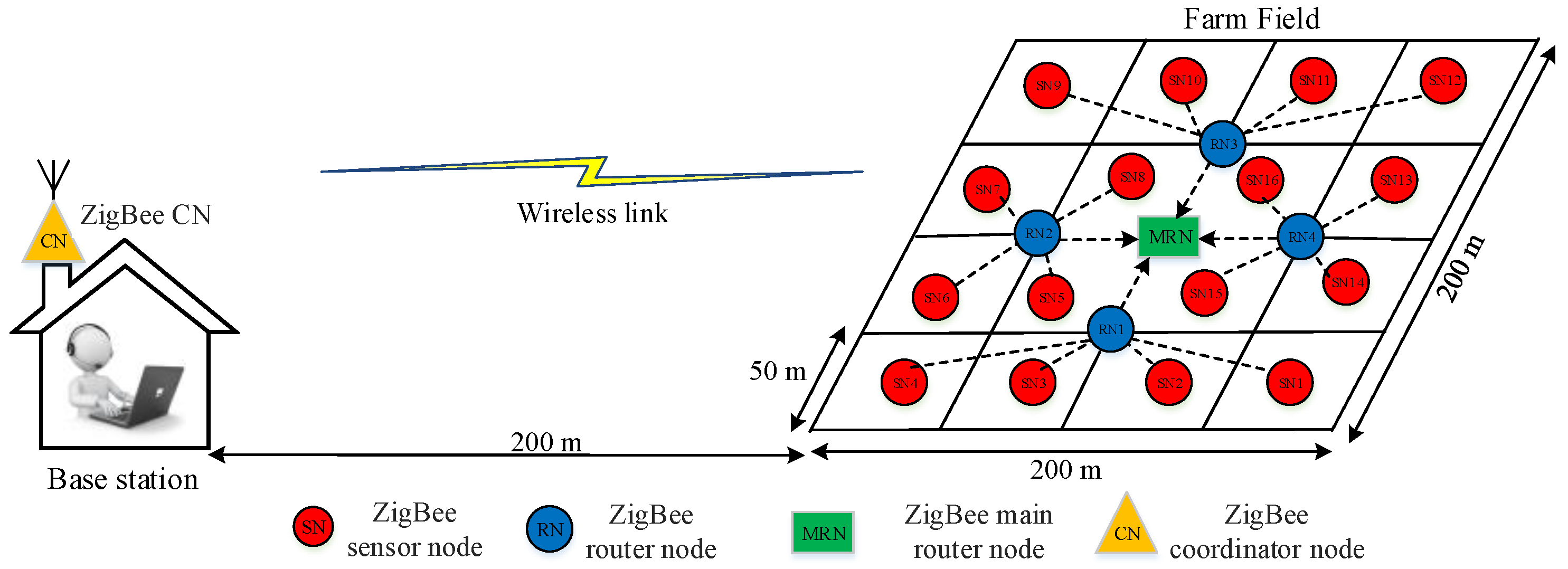
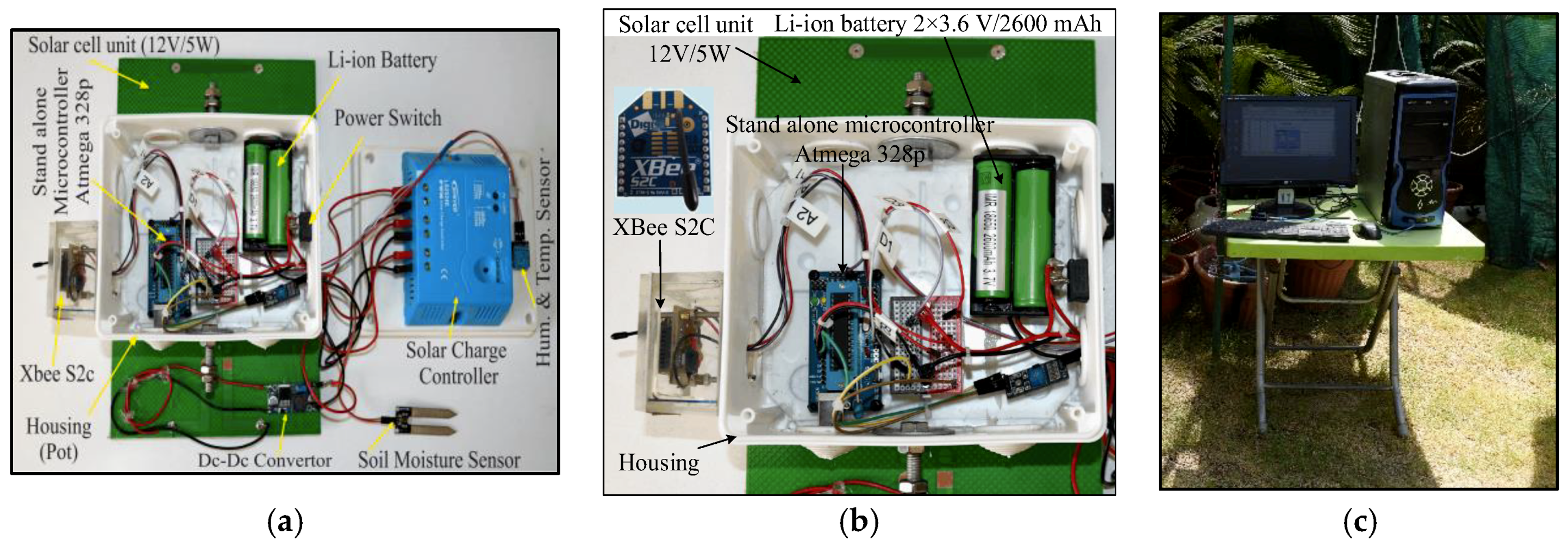
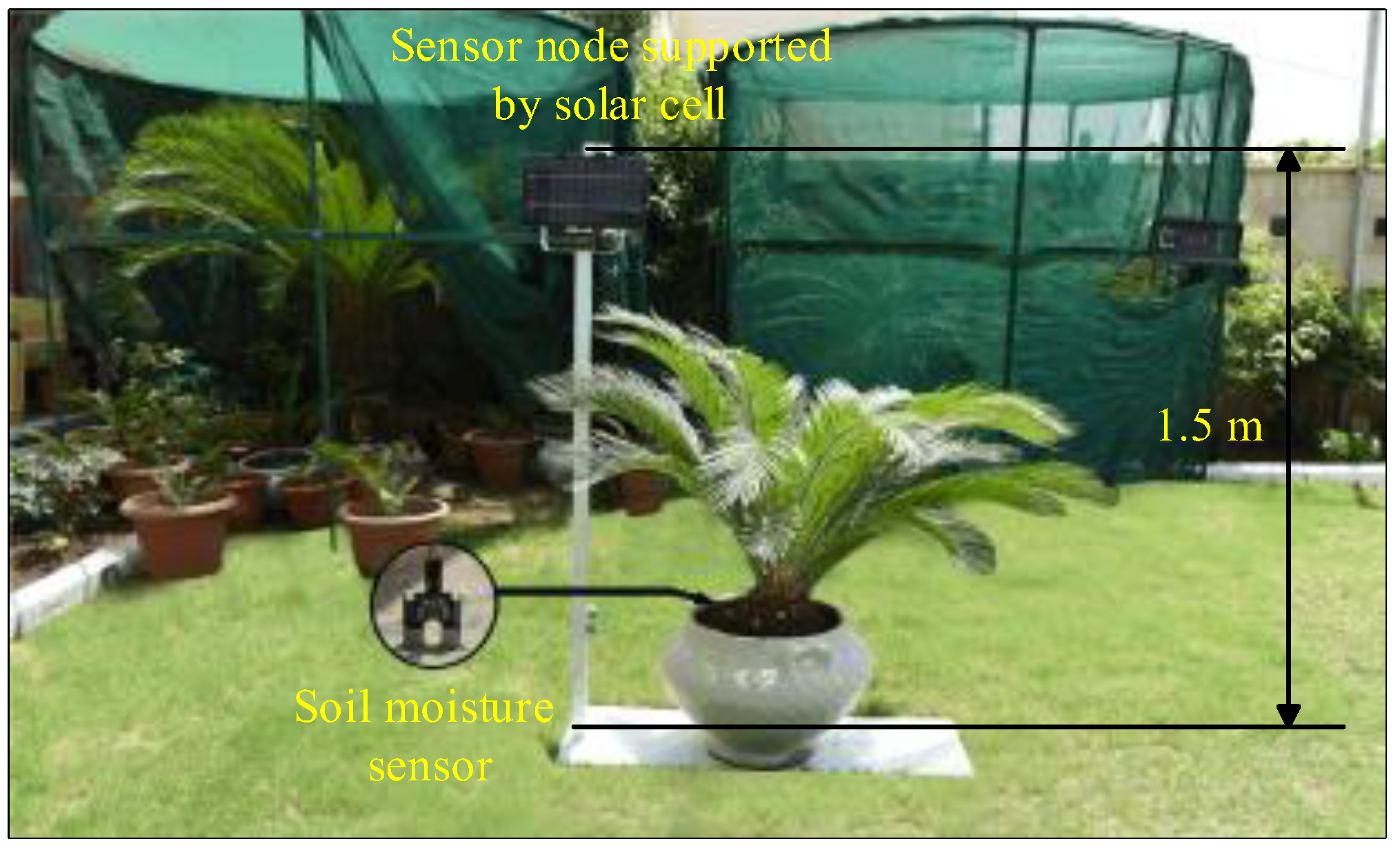


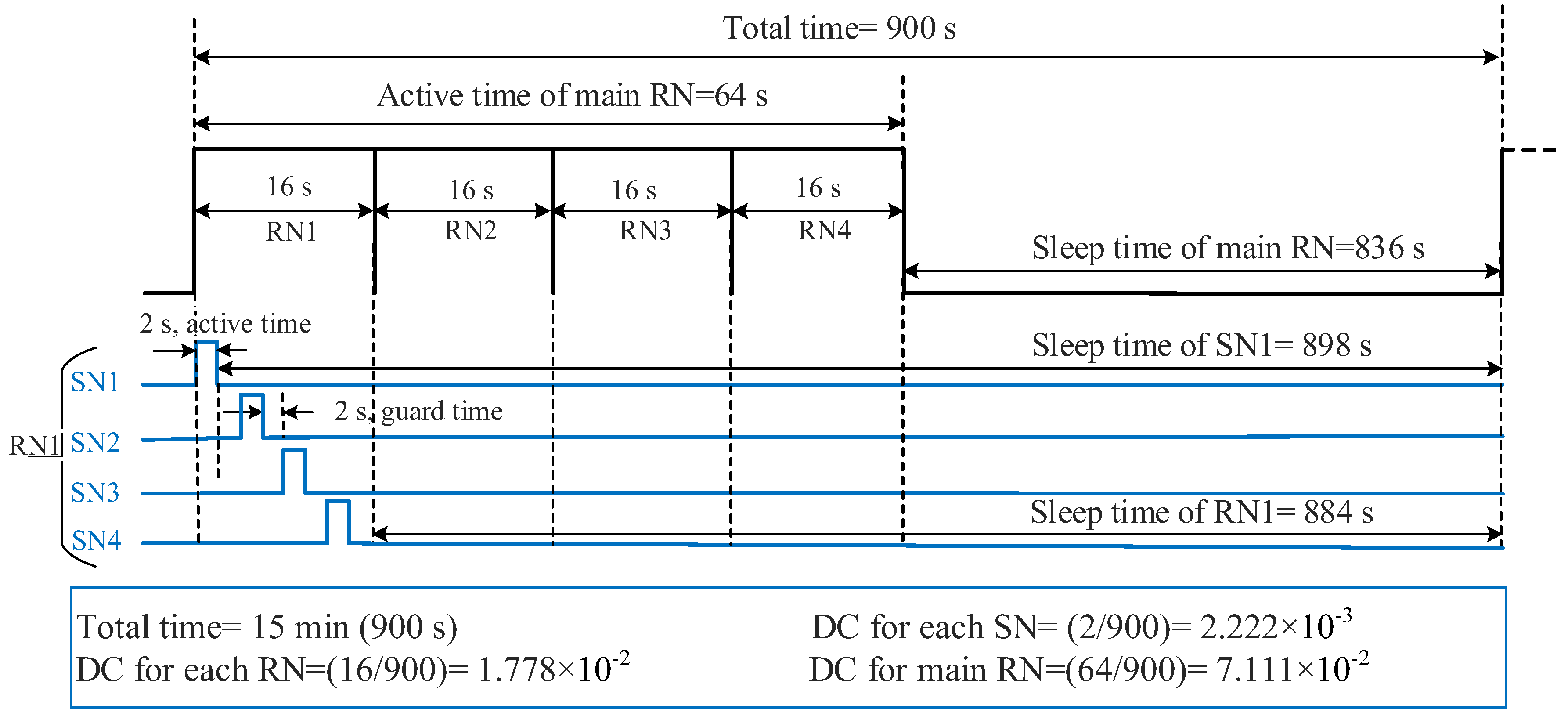
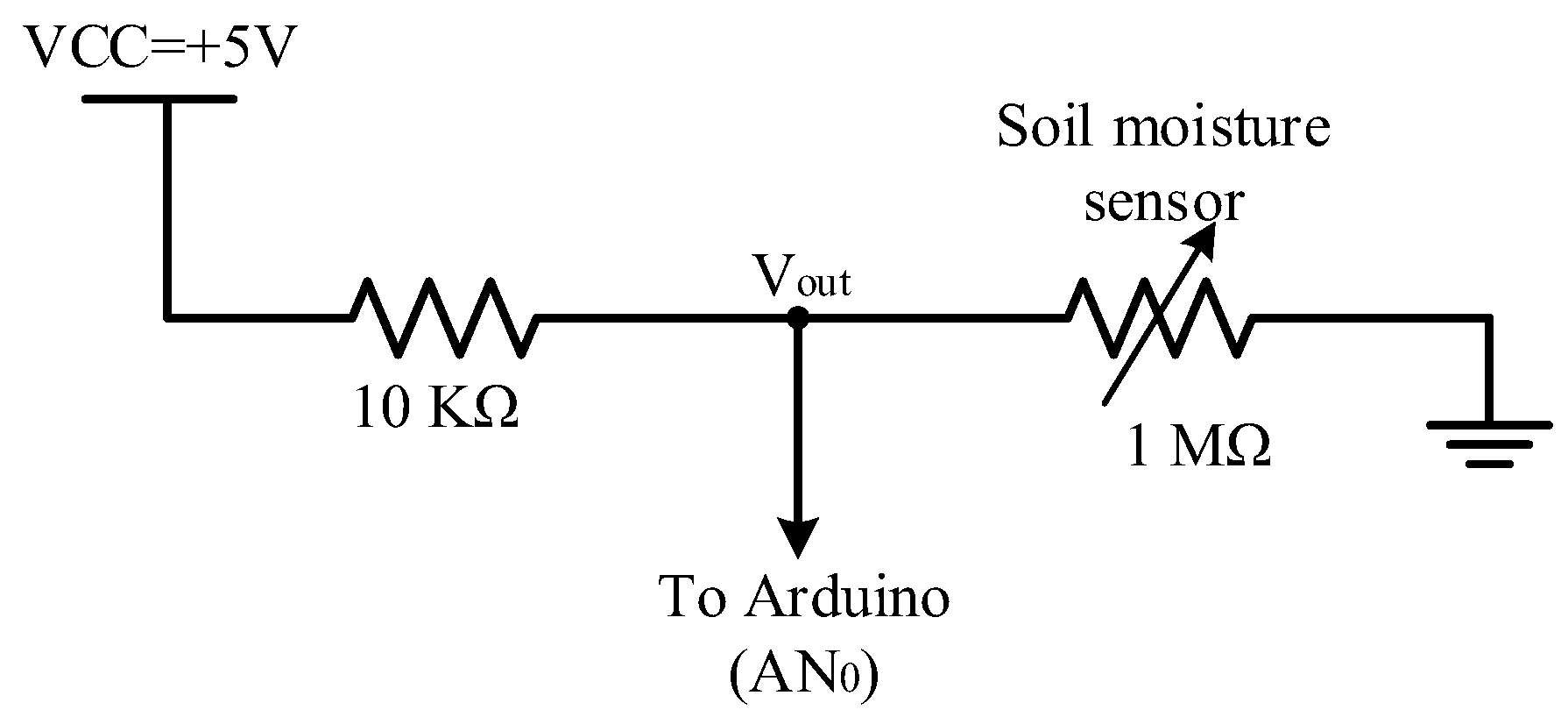

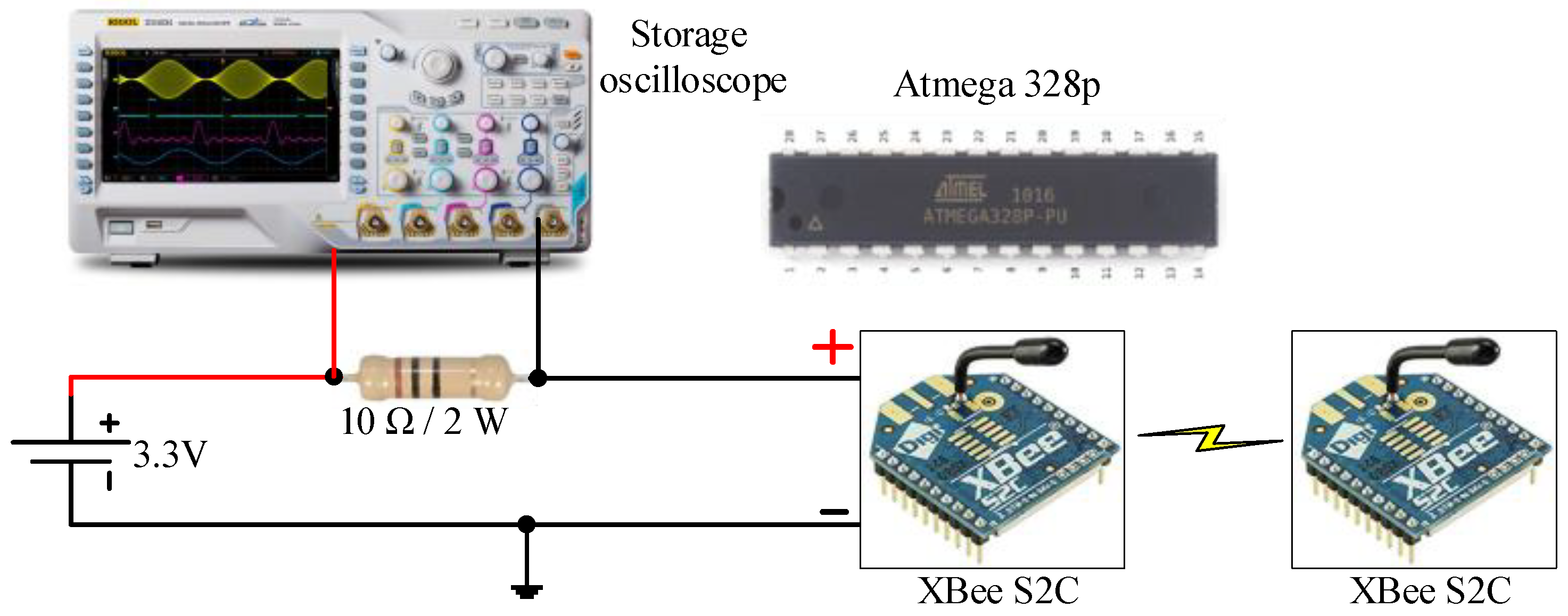
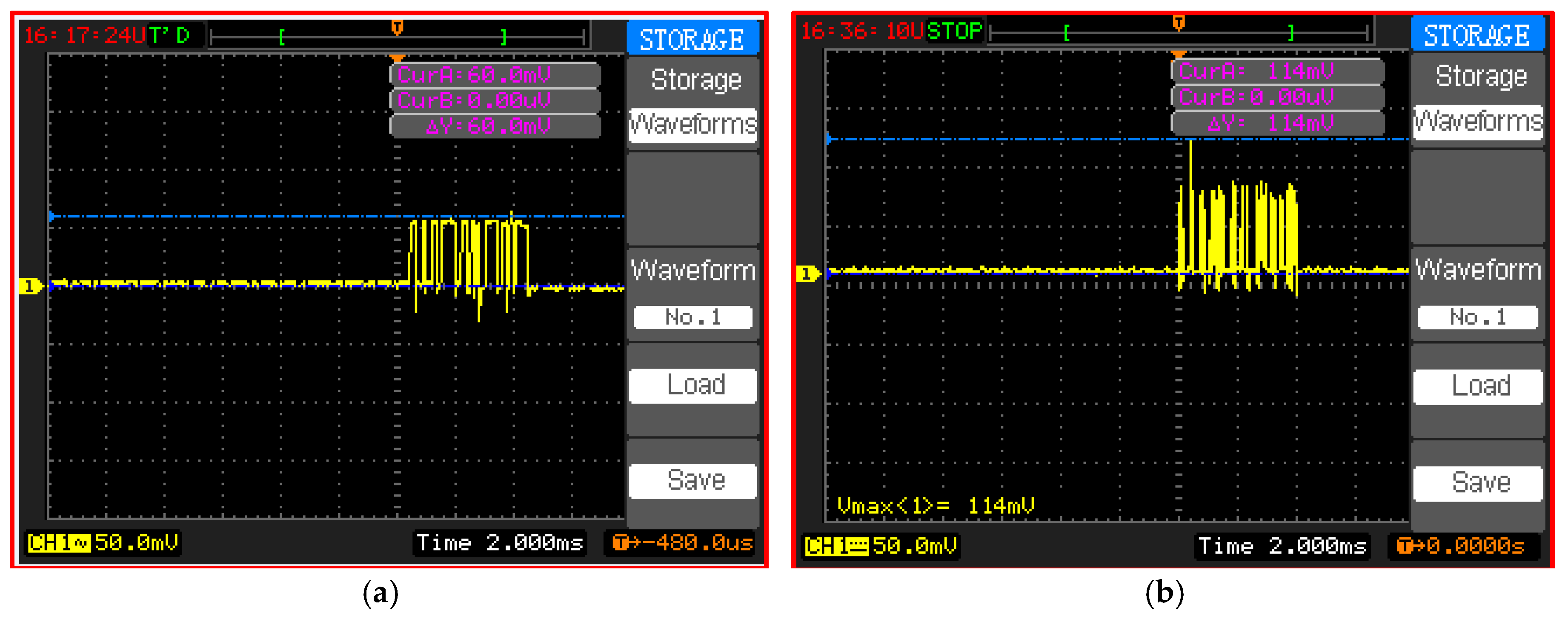


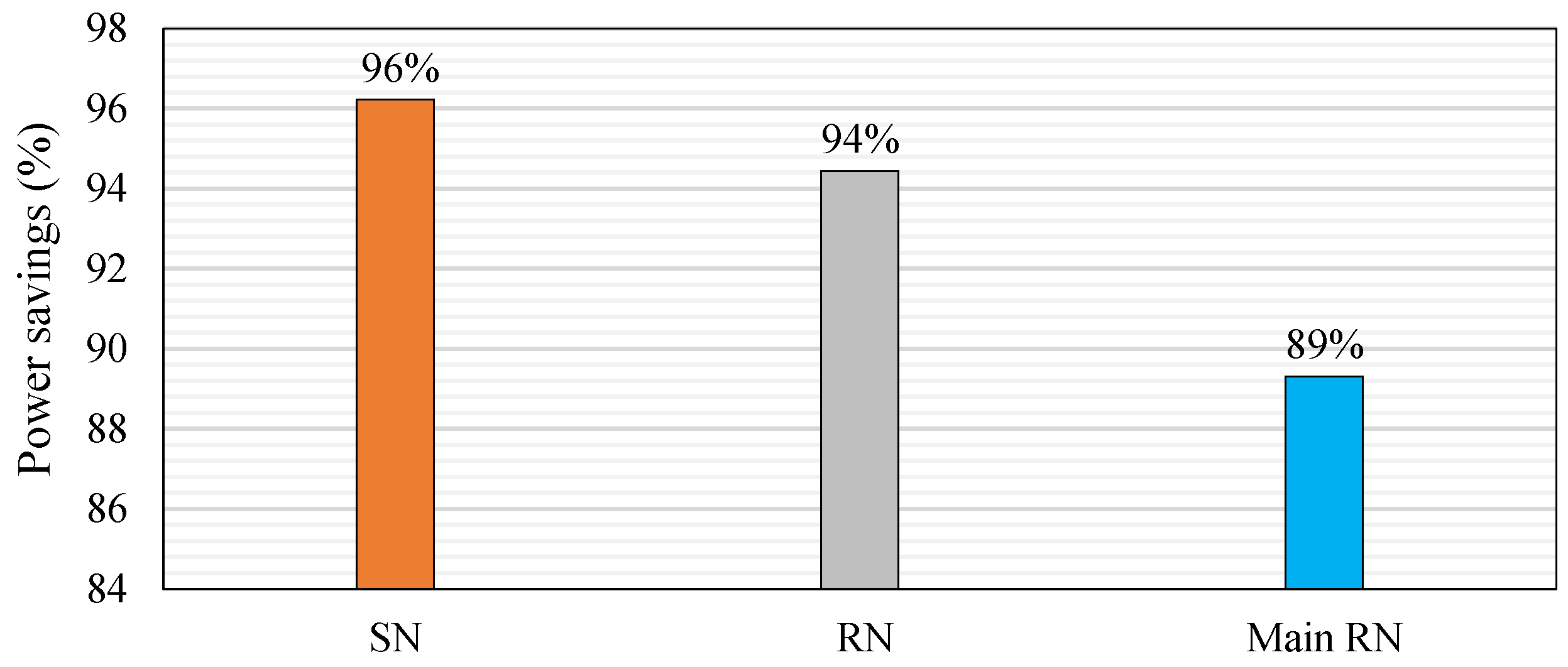

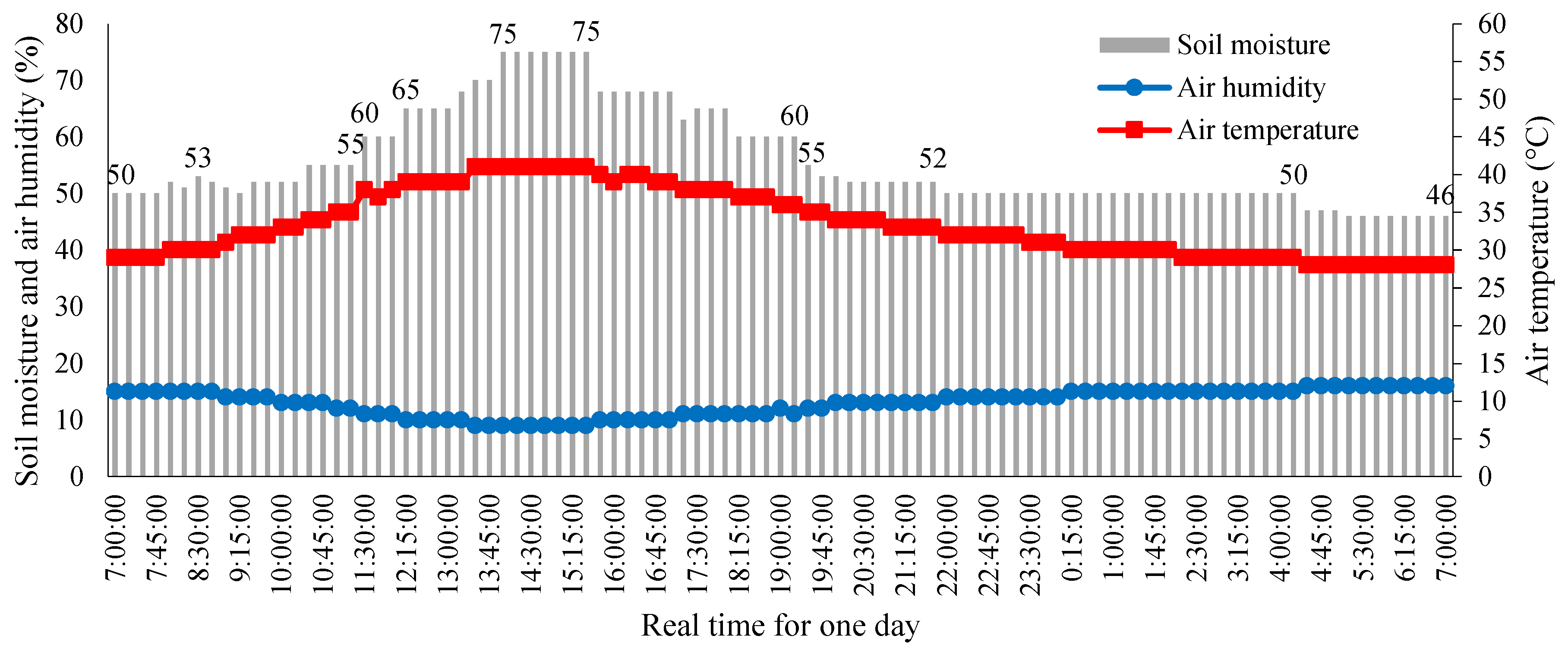
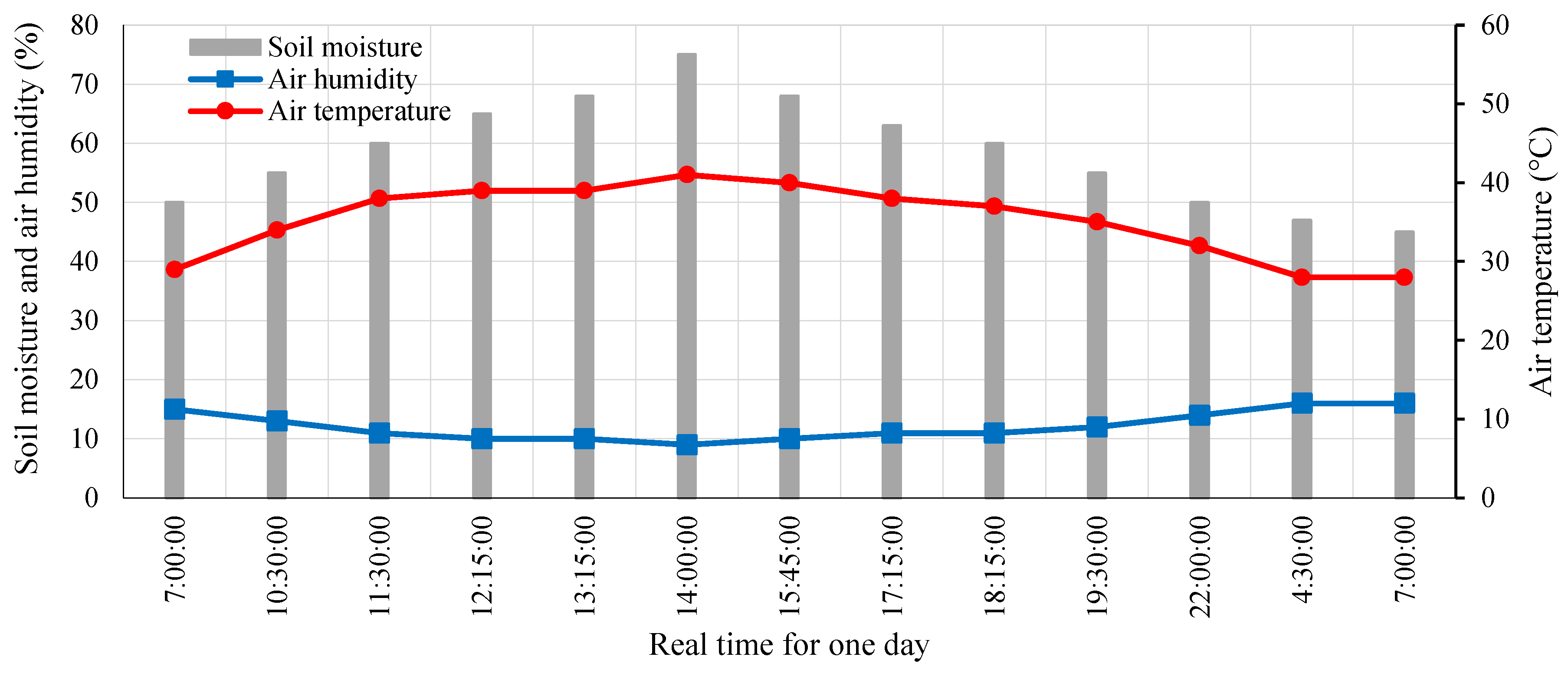
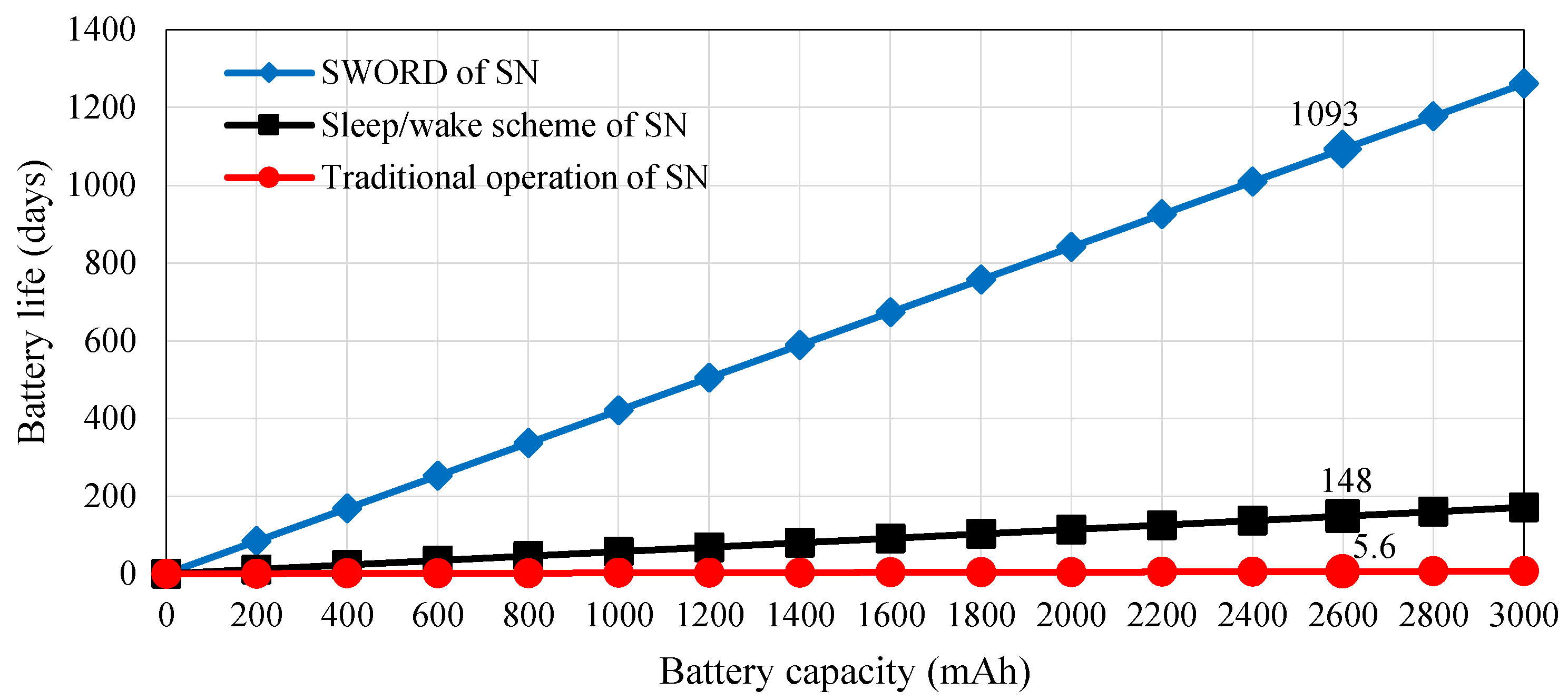
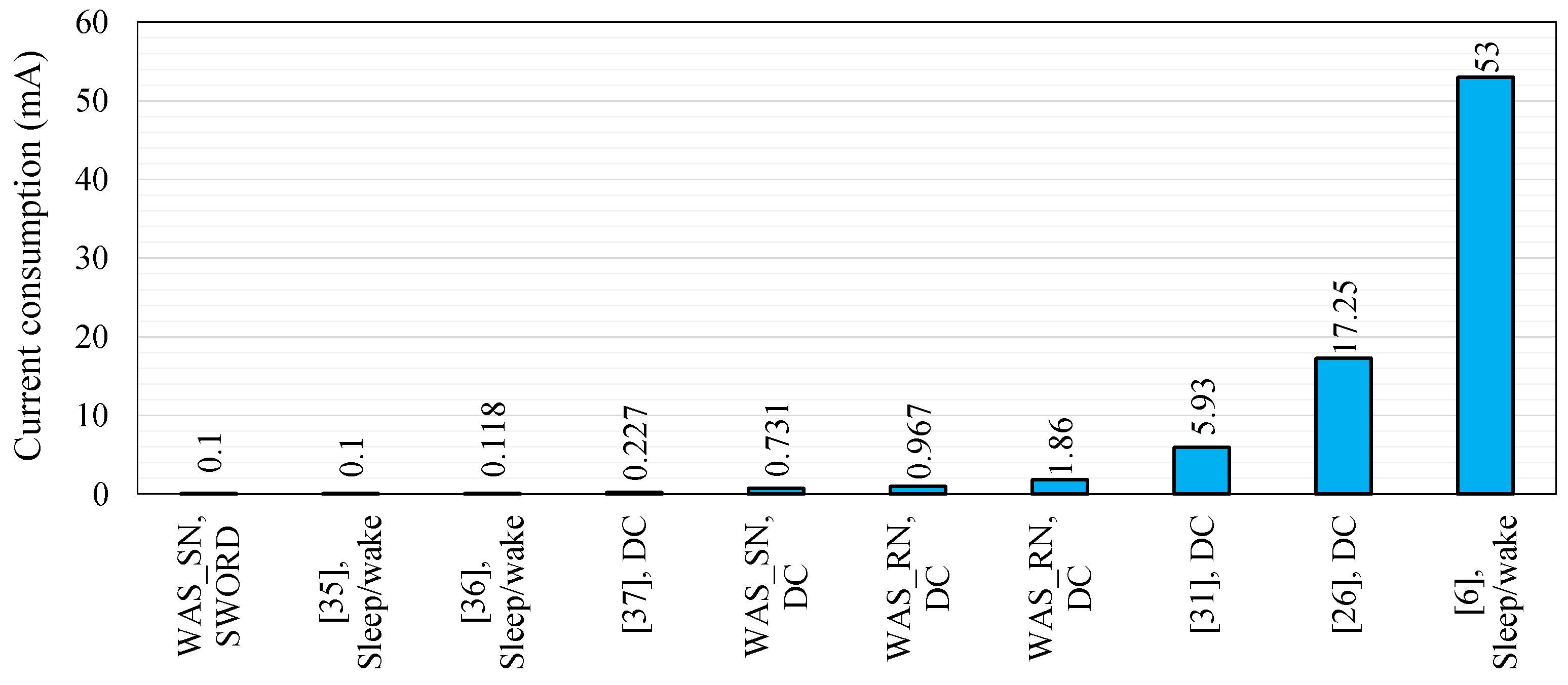
| Reference | Type of Microcontroller | Type of Wireless Protocol | Type of Sensor | Type of Battery Cell | Current/Voltage/Power of Solar Panel | Techniques for Reducing Power Consumption | Current or Power Consumption |
|---|---|---|---|---|---|---|---|
| [6] | 8051 | Zigbee-based CC2530 | Temperature, humidity, moisture | Lead-acid 6 V/4500 mAh | 9 V/5 W | Solar panel and DC (sleep) | 53 mA |
| [25] | 8051 | Zigbee | Temperature, humidity | Lithium 3.7 V/2500 mAh | 4 V/120 mA | Solar panel and DC | 80 mA |
| [20] | MSP430F22x2, MSP430F22x4 | RF module, CC2500 | Temperature, humidity (SHT11) | AAA batteries 4.5 V/2000 mAh | N/A | Solar panel and DC (sleep mode) | 0.142 mA |
| [26] | MSP430 | Zigbee-based CC1120 | Wind speed and direction, temperature, humidity, rain gauge, water, pH level | Lead-acid 12 V/4500 mAh | 12 V/2 W | Solar panel and DC (sleep mode) | 17.25 mA |
| [27] | H8 “VS-WRC003LV” | 802.11a | Temperature, humidity | NiCad 2.4 V/1000 mA | 180 mW (sunny) 24 mW (shady) | Solar panel and DC | 11.11 mA |
| [28] | PCI32MX220F032B | Wi-Fi/Zigbee (IEEE 802.15.4) | Temperature, pH, DO | N/A | N/A | Solar panel and DC | 81.5 mA |
| [29] | MEGA 2560 | XBee | Passive infrared sensor | Lead-acid 6 V/4.5 Ah | 4.75 V | Solar panel and DC (sleep mode) | 27 Wh |
| [31] | N/A | Zigbee and GSM/GPRS | Moisture, temperature, pressure, water conductivity | Lithium-ion 3.7 V/1900 mAh | 5 V/0.8 W 160 mA | Solar panel and DC (sleep mode) | 5.93 mA |
| [24] | N/A | CC1110 | Temperature, humidity | 3.7 V/850 mAh | 500 mW | Solar panel and DC (sleep mode) | 4.427 mA |
| [32] | N/A | nRF24L01 | pH | Not used | N/A | DC (sleep mode) | 2.807 mA |
| [33] | Atmega 324P | LoRa | Soil temperature and moisture, air temperature and humidity, light intensity | NI-MH AA 2.4 V/2400 mAh | N/A | DC (sleep mode) | 0.544 mA |
| [34] | N/A | XBee PRO Series 2 | Soil moisture, volumetric water content | Lithium | 12 V/10 W | Solar panel and DC (sleep mode) | 177 mA (active mode) 3.5 µA (sleep mode) |
| [35] | MSP430F1611 | IEEE 802.15.4 (CC2420) | Air temperature and soil moisture | NiMH 4 V/2700 mAh | 12 V/6.5 Ah | Solar panel and sleep/wake scheme (MAC protocol) | 0.1 mA |
| [36] | MSP430F149 | IEEE 802.15.4 (CC2420) | Temperature, light intensity, and humidity | Lithium 2.7 V/2000 mAh | N/A | Sleep/wake scheme (MAC protocol) | 0.118 mA |
| [37] | 8051 | Zigbee (CC2530) | Soil temperature and moisture, temperature, and humidity | Lithium-ion 7 V/1000 mAh | 7 V/7 W | Solar panel and DC (sleep mode) | 0.227 mA |
| Number | Hardware Type | Description |
|---|---|---|
| 1 | Temperature and humidity sensor | DHT11 |
| 2 | Soil moisture sensor | YL-100 |
| 3 | Microcontroller | Atmega 328p as standalone |
| 4 | Wireless protocol | Zigbee based on XBee S2C [40,41] |
| 5 | Power systems | Li-ion battery (7.4 V/2600 mAh) |
| 6 | Power solar cell | KINGRO-004V (12 V/5 W) |
| 7 | DC–DC converter | LM 2596 |
| 8 | Charger controller | PWM-LS2024E |
| Parameter | Value |
|---|---|
| Output voltage | 12 V |
| Load voltage | 11.1 V |
| Maximum current | 416 mA |
| Maximum output power (Pmax) | 5 W |
| Dimension (L × W × T) | 185 × 285 × 3.2 mm3 |
| Surface area (S) | 527.25 cm2 |
| Components of Sensor Node | Components of Router Node | Components of Main Router Node | ||||||
|---|---|---|---|---|---|---|---|---|
| Parameters | Soil Moisture | DHT11 | Atmega 328p | XBee S2C | Atmega 328p | XBee S2C | Atmega 328p | XBee S2C |
| Iactive (mA) | 0.1 | 1.85 | 6 | 11.4 | 6 | 11.4 | 6 | 11.4 |
| Isleep (mA) | 0.01 | 0.01 | 0.09 | 0.58 | 0.09 | 0.58 | 0.09 | 0.58 |
| tactive (s) | 2 | 2 | 2 | 2 | 16 | 16 | 16 | 16 |
| tsleep (s) | 898 | 898 | 898 | 898 | 884 | 884 | 884 | 884 |
| Ttotal (s) | 900 | 900 | 900 | 900 | 900 | 900 | 900 | 900 |
| DC | 0.2222% | 0.2222% | 0.2222% | 0.2222% | 1.778% | 1.778% | 7.111% | 7.111% |
| Iavg (mA) | 0.0102 Equation (3) | 0.0140 Equation (4) | 0.103 Equation (5) | 0.604 Equation (6) | 0.195 Equation (5) | 0.772 Equation (6) | 0.51 Equation (5) | 1.35 Equation (6) |
| I (mA) | 19.35 Equation (2) | 17.4 Equation (12) | 17.4 Equation (12) | |||||
| Iavg (mA) | 0.731 Equation (7) | 0.967 Equation (13) | 1.86 Equation (13) | |||||
| Itotal (mA) | 309.6 Equation (8) | 69.6 Equation (14) | 17.4 Equation (14) | |||||
| Iavg_total (mA) | 11.703 Equation (9) | 3.869 Equation (15) | 1.86 Equation (15) | |||||
| Pavg = Iavg × V based on sleep/wake (mW) | Pavg_SN = 7.4 × 0.731 = 5.409 Equation (10) | Pavg_RN =7.4 × 0.967 = 7.155 Equation (10) | Pavg_RN = 7.4 × 1.86 = 13.764 Equation (10) | |||||
| P (mW) = I × V without sleep/wake | P = I × V = 7.4 V × 19.35 mA = 143.19 | P = 7.4 × 17.4 =128.76 | P = 7.4 × 17.4 =128.76 | |||||
| Llife with sleep/wake (days) | 148 (3554 h) Equation (11) | 112 (2687 h) Equation (11) | 58 (1398 h) Equation (11) | |||||
| Llife without sleep/wake (days) | 5.6 (134 h) Equation (11) | 6 (149 h) Equation (11) | 6 (149 h) Equation (11) | |||||
© 2018 by the authors. Licensee MDPI, Basel, Switzerland. This article is an open access article distributed under the terms and conditions of the Creative Commons Attribution (CC BY) license (http://creativecommons.org/licenses/by/4.0/).
Share and Cite
Jawad, H.M.; Nordin, R.; Gharghan, S.K.; Jawad, A.M.; Ismail, M.; Abu-AlShaeer, M.J. Power Reduction with Sleep/Wake on Redundant Data (SWORD) in a Wireless Sensor Network for Energy-Efficient Precision Agriculture. Sensors 2018, 18, 3450. https://doi.org/10.3390/s18103450
Jawad HM, Nordin R, Gharghan SK, Jawad AM, Ismail M, Abu-AlShaeer MJ. Power Reduction with Sleep/Wake on Redundant Data (SWORD) in a Wireless Sensor Network for Energy-Efficient Precision Agriculture. Sensors. 2018; 18(10):3450. https://doi.org/10.3390/s18103450
Chicago/Turabian StyleJawad, Haider Mahmood, Rosdiadee Nordin, Sadik Kamel Gharghan, Aqeel Mahmood Jawad, Mahamod Ismail, and Mahmood Jawad Abu-AlShaeer. 2018. "Power Reduction with Sleep/Wake on Redundant Data (SWORD) in a Wireless Sensor Network for Energy-Efficient Precision Agriculture" Sensors 18, no. 10: 3450. https://doi.org/10.3390/s18103450
APA StyleJawad, H. M., Nordin, R., Gharghan, S. K., Jawad, A. M., Ismail, M., & Abu-AlShaeer, M. J. (2018). Power Reduction with Sleep/Wake on Redundant Data (SWORD) in a Wireless Sensor Network for Energy-Efficient Precision Agriculture. Sensors, 18(10), 3450. https://doi.org/10.3390/s18103450







